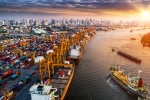
Non-oil growth is robust as inflation cools
Inflation cools in Gulf
Inflation remains a serious challenge for many countries globally, including commodity-importing countries in our region, such as Egypt. However, in the Gulf it peaked at an 11-year high of about 4.8% in July 2022 and since then has been steadily cooling, easing to 4.0% in November and is forecast by the IMF to average just 2.7% in 2023.
There are several reasons for this climate of moderate inflation. Subsidies and price controls on fuel, electricity and food help keep prices under control in most GCC countries. The strong US dollar, to which Gulf currencies are pegged, has played a supportive role in mitigating imported inflation in a region that relies heavily on imports. Despite the similarities of the GCC economies, there is still quite a range in inflation rates from 2.1% in Oman in November to an estimated 6.3% in the UAE.

But some inflation components remain high in places
The divergences are due to significant differences between countries in the weights of components in their inflation baskets and certain local trends. One of the most notable areas of divergence is the recreation component which is responsible for nearly half of Qatar’s inflation this year; without this Qatar would have the region’s second lowest inflation, rather than its second highest. Recreation comprises 11% of Qatar’s basket, compared with an average 3% for the rest of the Gulf, which was up by 23% year on year (y/y) in November vs just 2% for the rest of the GCC (excluding the UAE, which is likely also high because Dubai, another aviation hub, recorded 21% in November). This is because it is largely driven by the cost of air travel, which fell sharply in Qatar during the pandemic, given Qatar Airways’ large spare capacity, but has since rebounded, with a further boost from World Cup demand.
Qatar has also seen a surge in housing rents, which hit a 14-year high of 12.5% y/y in November, a short-term factor related to the World Cup. By contrast, rents in Bahrain declined by -0.5% (although rents only comprise 21% of the basket in Qatar, vs a regional high of 41% in Dubai). Conversely, food prices are highly controlled in Qatar and were only up 1.2% y/y compared with a 12.7% surge in neighbouring Bahrain. Bahrain also led the region on hospitality, up 10.8% y/y as Saudi tourists return in large numbers, whereas in Kuwait it was just 2.3%.
Transport prices were up by 8.9% y/y in Dubai because fuel is not subsidised (the UAE stopped publishing national monthly inflation data in 2022 but it is likely to be similar to Dubai), although this was down from a peak of 39% in July whereas in Qatar, where there are subsidies, saw a -2.5% decline in November. Some other components, such as communications and education, saw little inflation across the GCC..

The GCC mirrors US rate rises
The modest levels of inflation in the region mean that there is little need to mitigate it with monetary policy interventions. However, pegged currencies mean that Gulf states are largely obliged to mirror interest rates hikes in the US or risk capital outflows. As a result, they continued to follow the US Fed’s interest rate rises, which totalled +125 bp of hikes in November and December. Only Kuwait’s policy rate of 3.5% is less than the US and was only increased by +50 bp in the same period. This is possible because of the slight policy flexibility that comes from Kuwait’s peg to a basket of currencies, albeit one dominated by the dollar.
The higher rates have created some concerns that they could reduce demand for credit and in turn reduce private consumption and investment, hurting the non-oil economy. So far there is little sign of that and a policy paper on the GCC published by the IMF in November 2022 found evidence from historical analysis that non-oil growth in the region was not particularly sensitive to interest rate hikes at times when (as at present) oil prices are high and hence support domestic liquidity.
Non-oil growth trends look solid in 2022
The latest available data for Q3 shows solid non-oil growth in Saudi Arabia, Dubai and Bahrain. Oman suffered a -1% y/y contraction, but that was due to weakness in the construction sector (down -22% y/y) that has been ongoing since the start of the year. Excluding this, the rest of its non-oil sector grew by 4.2%. Saudi Arabia, in particular, is showing strong momentum, supported by government spending and economic reforms, and every individual sector was back to pre-COVID-19 levels in Q3 and the non-oil sector as a whole was 8.4% larger. Although certain sectors, particularly transport and hospitality, have not yet fully recovered in other GCC states, they are making good progress.
Leading indicators point to continued robust growth in Q4, during which the Purchasing Managers’ Index for Saudi Arabia reached a three-year high of 57.5 on average (with readings >50 associated with non-oil expansion) and the UAE a solid 55.1, albeit down slightly on Q3 (which was its own three-year high). The exception is Qatar which saw a sharp decline to 48.9 in Q4 as the frenetic construction activity observed in the run-up to the World Cup, came to an end. However, although this theoretically suggests a Q4 contraction in Qatar, this is unlikely to be the case given the consumption boost coming from the tournament itself. However, Qatar could face some weakness in 2023 as migrant workers and the tourism boost related to the World Cup depart.


Contact us


Richard Boxshall
Global Economics Leader and Middle East Chief Economist, PwC Middle East
Tel: +971 (0)4 304 3100








